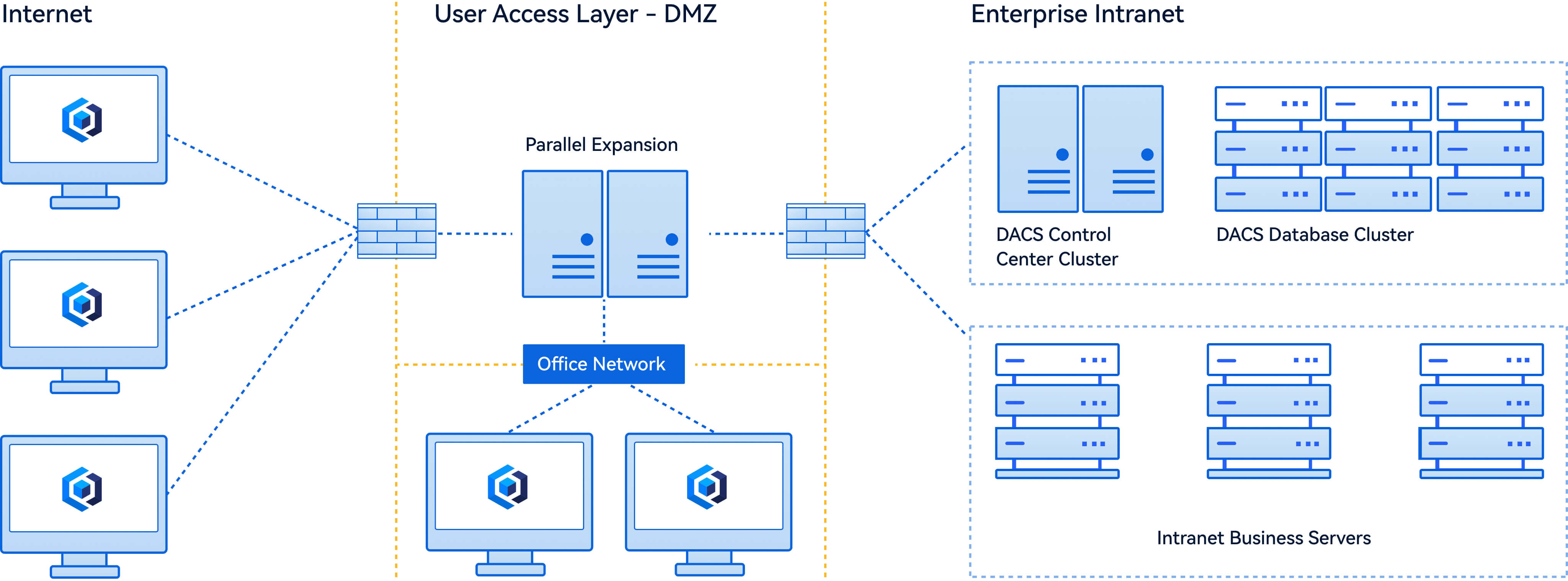最新发布|DACS-Gaming游戏行业解决方案重磅升级
了解更多Industry Best Practices, Rapid Deployment Delivery
DACS supports multiple delivery methods, such as privatization deployment and SaaS services, with pure software form and standardized deployment, covering single data center, multi-branch access, cross-regional multi-data center and other scenarios, enterprises can flexibly choose to match according to their own business construction.

Single cluster mode
The single cluster mode is usually adopted for small and medium-sized enterprises. The DACS security management platform server takes over the internal data network entrance and provides access to the terminal devices which are from Internet or in the enterprise office environment, supporting service redundancy, with the advantageous features of high performance, high availability and high scalability, guaranteeing the stability of the cluster service and allowing parallel expansion.

Multi-branch access mode
For enterprises with multiple branches, a multi-branch access deployment mode can be used to provide access to terminal devices from the enterprise office environment, the branch environment and the Internet environment, where the Internet access terminal can choose the nearest access point to access according to the geographical location.

The standard deployment architecture of DACS core service clusters in the enterprise headquarters data center is the same as the single cluster mode, with the difference that DACS access authentication gateways need to be deployed at the network outlet of each branch, and terminal devices in each branch network access the headquarters data center through their respective gateway clusters to securely access intranet services. Terminal devices in the Internet can choose the nearest access point for secure access according to the geographical location.
Cross-regional multi-cluster mode
For large enterprises that collaborate across geographical offices, have multiple data centers and have special requirements for system disaster tolerance capability, they often have redundancy requirements for the access points of the internal data network, and can adopt a cross-regional multi-center deployment mode to meet the requirements, with data backup between clusters of centers, and when a single point server room or network fails, the terminal equipment will automatically switch to other access points to enter the internal data network to ensure uninterrupted business access.

Industry Best Practices, Rapid Deployment Delivery
DACS supports multiple delivery methods, such as privatization deployment and SaaS services, with pure software form and standardized deployment, covering single data center, multi-branch access, cross-regional multi-data center and other scenarios, enterprises can flexibly choose to match according to their own business construction.

Single cluster mode
The single cluster mode is usually adopted for small and medium-sized enterprises. The DACS security management platform server takes over the internal data network entrance and provides access to the terminal devices which are from Internet or in the enterprise office environment, supporting service redundancy, with the advantageous features of high performance, high availability and high scalability, guaranteeing the stability of the cluster service and allowing parallel expansion.

Multi-branch access mode
For enterprises with multiple branches, a multi-branch access deployment mode can be used to provide access to terminal devices from the enterprise office environment, the branch environment and the Internet environment, where the Internet access terminal can choose the nearest access point to access according to the geographical location.

The standard deployment architecture of DACS core service clusters in the enterprise headquarters data center is the same as the single cluster mode, with the difference that DACS access authentication gateways need to be deployed at the network outlet of each branch, and terminal devices in each branch network access the headquarters data center through their respective gateway clusters to securely access intranet services. Terminal devices in the Internet can choose the nearest access point for secure access according to the geographical location.
Cross-regional multi-cluster mode
For large enterprises that collaborate across geographical offices, have multiple data centers and have special requirements for system disaster tolerance capability, they often have redundancy requirements for the access points of the internal data network, and can adopt a cross-regional multi-center deployment mode to meet the requirements, with data backup between clusters of centers, and when a single point server room or network fails, the terminal equipment will automatically switch to other access points to enter the internal data network to ensure uninterrupted business access.

Contact Us